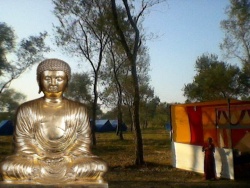Difference between revisions of "Dhānyakataka"
(Created page with " thumb|250px| Dharanikota is a town near Amaravati in the Guntur district of Andhra Pradesh in India, which means a town of {{Wiki|rice}} ...") |
|||
| Line 8: | Line 8: | ||
Importance | Importance | ||
| − | It is the site of the {{Wiki|ancient}} [[Dhanyakataka]] which was the capital of the [[Satavahana]] {{Wiki|kingdom}} which ruled in the Deccan around the 1st to 3rd centuries A.D.. It was also the capital of the | + | It is the site of the {{Wiki|ancient}} [[Dhanyakataka]] which was the capital of the [[Satavahana]] {{Wiki|kingdom}} which ruled in the Deccan around the 1st to 3rd centuries A.D.. It was also the capital of the [[Kota Vamsa Dynasty]] which ruled in {{Wiki|medieval}} period until mid 12th century. The [[Krishna]] valley is an important {{Wiki|rice}} producing area. It was also an important centre of trade with other parts of [[India]] and foreign countries. The place is also famous for the great [[Buddhist]] [[stupa]] and [[Kalachakra]] {{Wiki|ceremonies}} conducted there. [[Hsuan Tsang]] visited [[Amaravathi]] and wrote a glorious account of the place, [[Viharas]] and [[monasteries]] that existed then. |
{{W}} | {{W}} | ||
[[Category:India]] | [[Category:India]] | ||
Latest revision as of 08:04, 25 April 2014
Dharanikota is a town near Amaravati in the Guntur district of Andhra Pradesh in India, which means a town of rice or paddy.
Location
It located in the Krishna valley in the Guntur district of Andhra Pradesh in India.
Importance
It is the site of the ancient Dhanyakataka which was the capital of the Satavahana kingdom which ruled in the Deccan around the 1st to 3rd centuries A.D.. It was also the capital of the Kota Vamsa Dynasty which ruled in medieval period until mid 12th century. The Krishna valley is an important rice producing area. It was also an important centre of trade with other parts of India and foreign countries. The place is also famous for the great Buddhist stupa and Kalachakra ceremonies conducted there. Hsuan Tsang visited Amaravathi and wrote a glorious account of the place, Viharas and monasteries that existed then.
